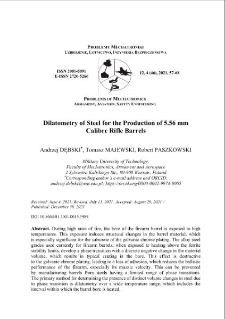Nasza Biblioteka Cyfrowa udostępnia 1 868 obiektów cyfrowych
Obiekt
Tytuł: Dilatometry of Steel for the Production of 5.56 mm Calibre Rifle Barrels ; Dilatometry of Steel for the Production of 5.56 mm Calibre Rifle Barrels
Tytuł odmienny:
Badania dylatometryczne stali do produkcji luf 5,56 mm ; Badania dylatometryczne stali do produkcji luf 5,56 mm
Współtwórca:
Tomasz MAJEWSKI, Robert PASZKOWSKI ; Tomasz MAJEWSKI, Robert PASZKOWSKI
Abstrakt:
During high rates of fire, the bore of the firearm barrel is exposed to high temperatures. This exposure induces structural changes in the barrel material, which is especially significant for the substrate of the galvanic chrome plating. The alloy steel grades used currently for firearm barrels, when exposed to heating above the ferrite stability limits, develop a phase transition with a discrete negative change in the material volume, which results in typical crazing in the bore. This effect is destructive to the galvanic chrome plating, leading to a loss of adhesion, which reduces the ballistic performance of the firearm, especially its muzzle velocity. This can be prevented by manufacturing barrels from steels having a limited range of phase transitions. The primary method for determining the presence of distinct volume changes in steel due to phase transition is dilatometry over a wide temperature range, which includes the interval within which the barrel bore is heated. This paper presents the dilatometry results for four steel grades, which included a steel grade currently used for firearm barrels, and an analysis of the effects of phase transition on the degradation of the barrel bore.
;
During high rates of fire, the bore of the firearm barrel is exposed to high temperatures. This exposure induces structural changes in the barrel material, which is especially significant for the substrate of the galvanic chrome plating. The alloy steel grades used currently for firearm barrels, when exposed to heating above the ferrite stability limits, develop a phase transition with a discrete negative change in the material volume, which results in typical crazing in the bore. This effect is destructive to the galvanic chrome plating, leading to a loss of adhesion, which reduces the ballistic performance of the firearm, especially its muzzle velocity. This can be prevented by manufacturing barrels from steels having a limited range of phase transitions. The primary method for determining the presence of distinct volume changes in steel due to phase transition is dilatometry over a wide temperature range, which includes the interval within which the barrel bore is heated. This paper presents the dilatometry results for four steel grades, which included a steel grade currently used for firearm barrels, and an analysis of the effects of phase transition on the degradation of the barrel bore.
Miejsce wydania:
Warszawa
;
Warszawa
Wydawca:
Wojskowa Akademia Techniczna ; Wojskowa Akademia Techniczna
Data utworzenia:
Data złożenia:
Data akceptacji:
Data wydania:
Rozmiar:
Identyfikator:
oai:ribes-88.man.poznan.pl:2624
Sygnatura:
DOI 10.5604/01.3001.0015.5989 ; DOI 10.5604/01.3001.0015.5989
ISSN elektroniczny:
ISSN drukowany:
Język:
Licencja:
kliknij tutaj, żeby przejść ; kliknij tutaj, żeby przejść
Właściciel praw:
Wojskowa Akademia Techniczna ; Wojskowa Akademia Techniczna
Strona początkowa:
Strona końcowa:
Tom:
Słowa kluczowe:
mechanical engineering, firearm barrels, dilatometry ; mechanical engineering, firearm barrels, dilatometry
Kolekcje, do których przypisany jest obiekt:
Data ostatniej modyfikacji:
3 paź 2025
Data dodania obiektu:
3 paź 2025
Liczba wyświetleń treści obiektu:
0
Wszystkie dostępne wersje tego obiektu:
https://ribes-88.man.poznan.pl/publication/2948
Wyświetl opis w formacie RDF:
Wyświetl opis w formacie OAI-PMH:
| Nazwa wydania | Data |
|---|---|
| Dilatometry of Steel for the Production of 5.56 mm Calibre Rifle Barrels | 3 paź 2025 |
Obiekty Podobne
Andrzej DĘBSKI Piotr KONIORCZYK, Zbigniew LECIEJEWSKI, Marek PREISKORN, Zbigniew SURMA, Janusz ZMYWACZYK

